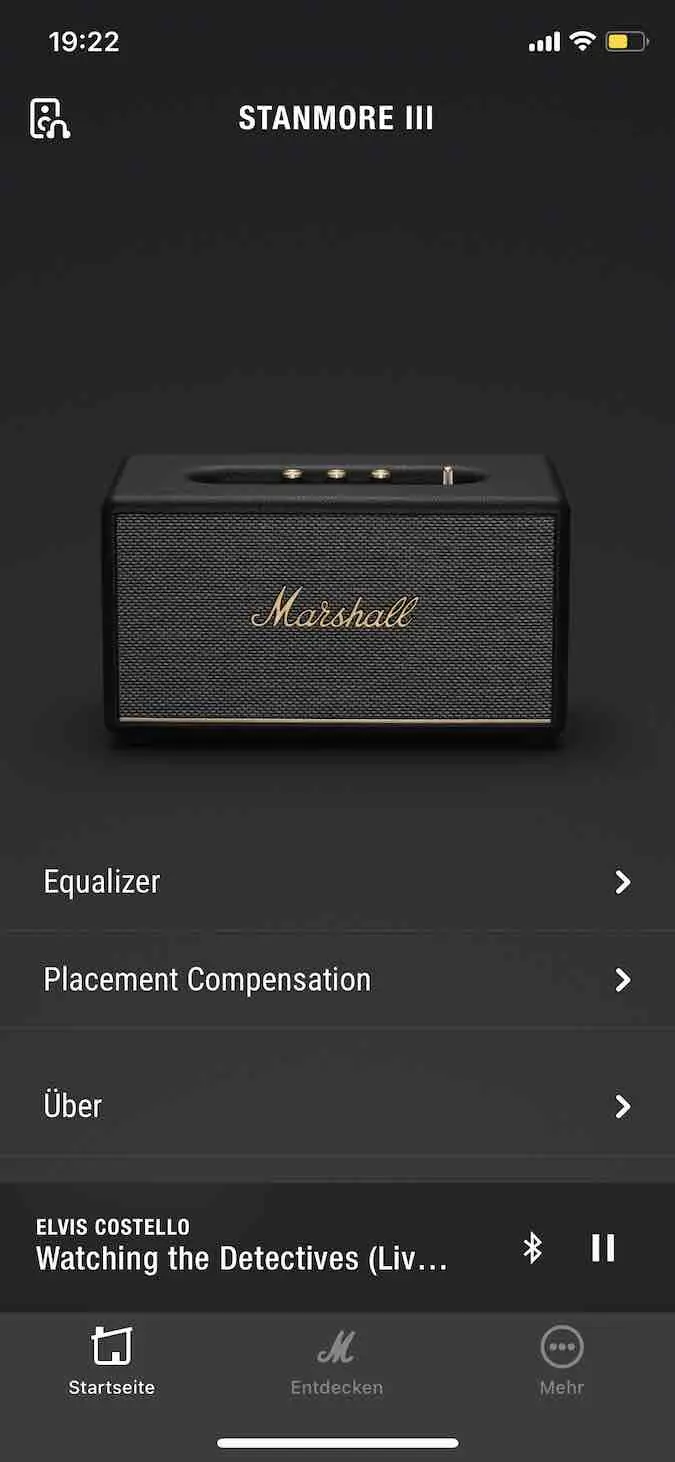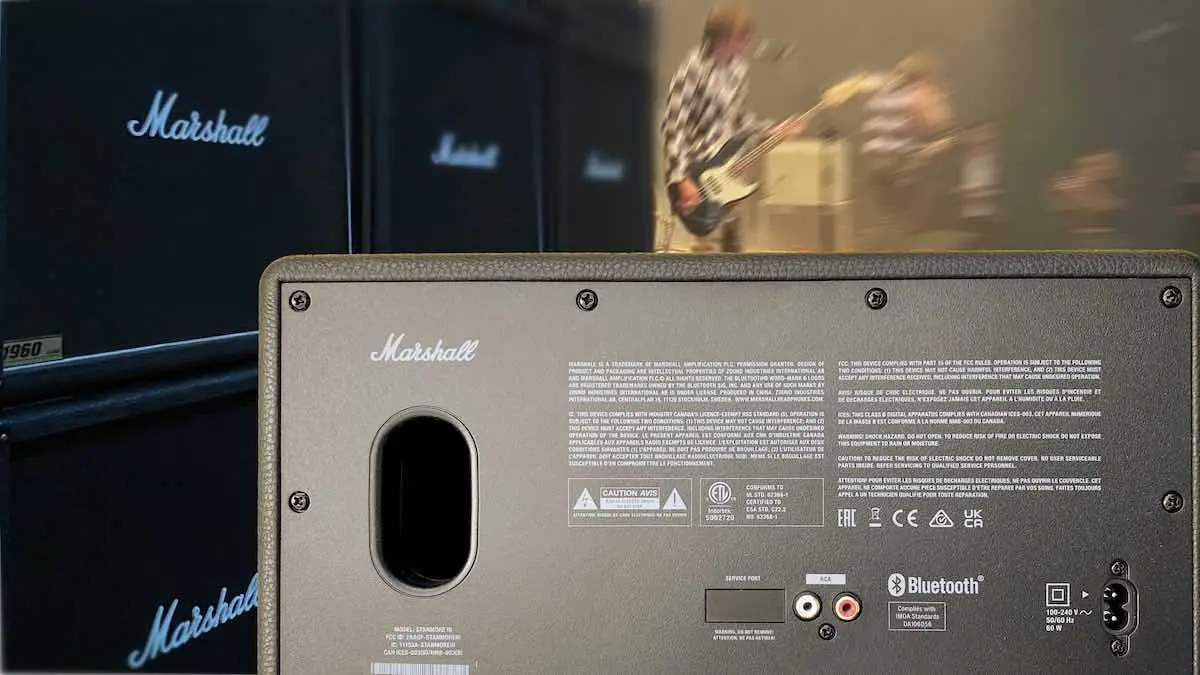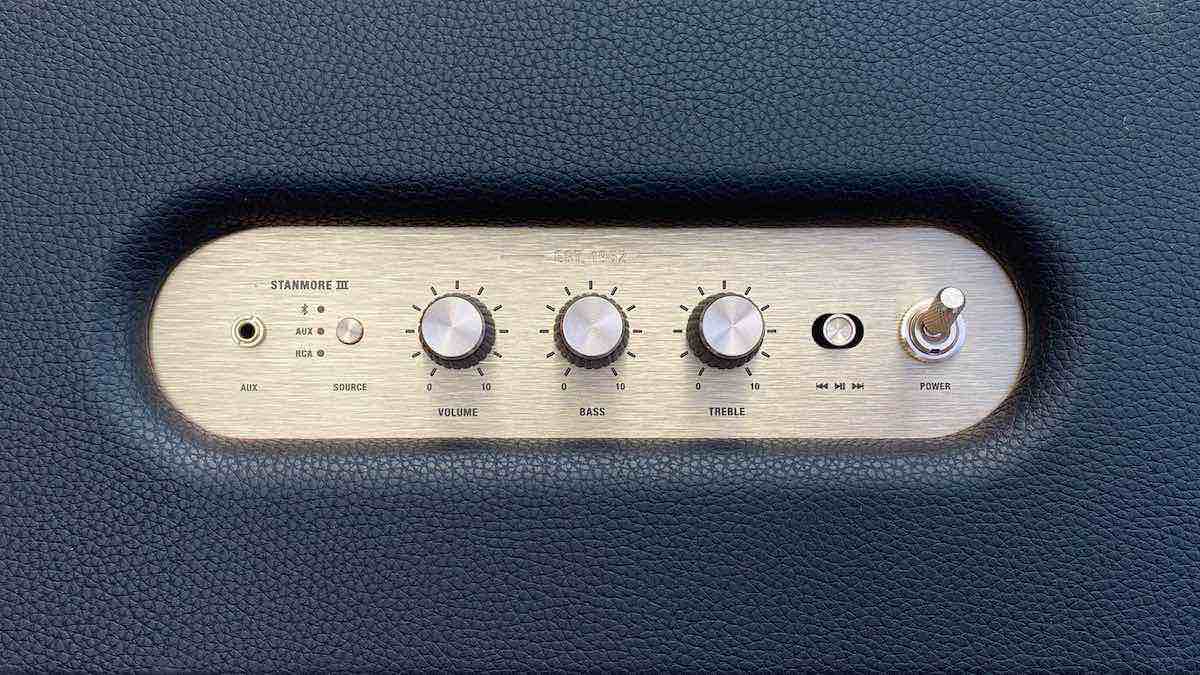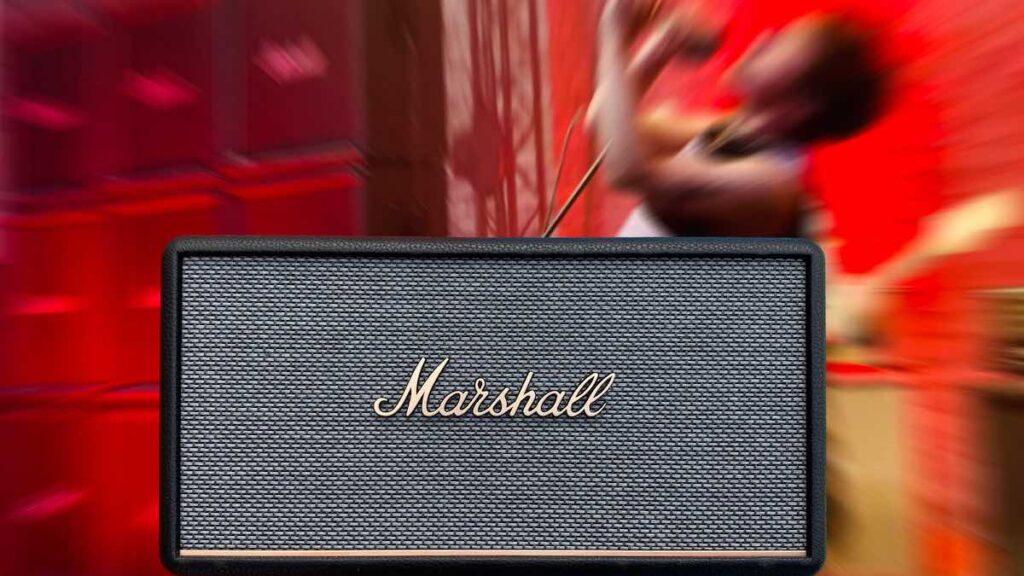STEREO GUIDE verdict
+ Homogeneous with good live feeling
+ rich, differentiated, powerful bass
+ Room compensation
+ High quality workmanship
+ app
-
Sound: tonal balance / transparency8.1
-
Sound: Bass / Dynamics8.9
-
Ease-of-Use / Connectivity8.4
-
Price / Performance9.2
The Marshall Woburn 3 we recently reviewd offered a whopping 120 watts of power and 3-way crossover design. The new series of home-only Bluetooth speakers is completed by the Stanmore III, filling the gap between the compact Acton III and the bulky Woburn III. For those caring about interior design the height of the latter might be a show-stopper. The Stanmore III, however, might therefore be the best choice being harmoneously proportioned.
With a height of less than 8″, it looks great on any lowboard. Its spec sheet is hinting that it is technically closer to its bigger brother. Thus, if offers two analogue inputs and a whopping 80 watts of power. On the other hand, only 2-way crossover, no HDMI and still an affordable price point.
In any case: room compensation via app is included, and that turns out to be be very useful as the lower cutoff-frequency is promised to hit 45 Hz.
Stereo imaging from only the tweeters
The rather mature width of 14″ might make it tempting to include a proper stereo circuitry in order to create some imaging. In addition to the pure maximum distance between either channel, two tweeter domes are equipped with waveguides that are supposed to focus the directivity pattern away from the center to enlarge the stereo width. Separate 2-channel midrange drivers are not available for boosting this effect.
A single 5″ bass provides (mono) mids and plenty of low frequency. The latter is supported by a rear bass vent and a decent 50 watts of power.


App, tapping or turning?
Trying to operate the Stanmore III, we got a true ´Marshall feeling´: Powering it on means to flip a toggle switch like in the old days. Three control knobs finished with brass applications control volume, treble and bass. And they are, unlike with the predecessor, conveniently synchronized with your smartphone and Marshall´s latest app. Two-button control turned out to be the most intuitive in class: a classic key for selecting one of the three sources. And the push/slidee both for play/pause and track skip known from other Marshalls. We are impressed and don´t want any other control concept anymore!
The Marshall Bluetooth app for iOS and Android is nicely made, but remains puristic. In addition to the remote control replacement for the four controllers on the device, a logically explained acoustic room compensation is a special feature. You simply answer the questions whether the speaker is close to the wall or the corner, and the digital signal processor is dosing the bass accordingly.
No matter where it is positioned: With the very well-made, sturdy casing and beautiful design details, it cuts a fine figure anywhere in the home. Outside, however, not, because it requires mandatory power supply from the mains for operation. By the way, Marshall does not offer a battery-powered mobile speaker of comparable size in its lineup.
Holy trinity of sources
With Bluetooth 5.2 with AptX, the Marshall Stanmore III is up to date and enabled a stable connection at any time during the review process. It also handles two smartphones being connected simultaneously thanks to its multihost option. The connection should also enable firmware updates.
An analogue 3.5 mm input can be found on the brass-colored control panel on top. A stereo pair of RCA inputs is located at the very bottom of the rear panel for this purpose, which allows to connect a TV, CD player or turntable with phono amplifier.


This is how the Marshall Stanmore III sounds
In terms of sound, the Marshall Stanmore 3 shows its size advantage over the smaller Acton 3. Deep and loud bass essentially needs cabinet volume and this one conjures up an impressive performance. It gets deeper and sends beats into the room with more intensity. Furthermore, its imaginary staging seems wider and higher than its little brother’s. To speak of true stereo as known from separated stereo speakers would be an exaggeration. But at least we got some impression of ambience.
Tonally, the Stanmore 3 basically manages to find the golden path of ideal balance. The extremely rich bass can be adjusted by the Room Compensation in the app and should not cause any problems in normal rooms despite all its splendour. However, depending on which music you play, treble can sound a bit snotty and loud at higher SPL – and the Stanmore III is capable of playing really really loud.
The Stanmore´s qualities are especially evident with live music. You can get surprisingly close to the stage with this one. Offering formidable transparency and fine dynamics, you might hear lots of subtle details in complex recordings as you would expect from a true audiophile stereo system. For classical music, it might be a bit softer in the treble region. But for rock, pop and electro beats, the Stanmore 3 is made for the job.
Conclusion and alternatives
370 bucks for a puristic Bluetooth concept – you need good arguments for that. We can give the following: bass, dynamics and the feeling of having live music way above its class´ average, sensationally simple operation and a very well-made retro housing. So why not buy a Marshall Acton III instead? That´s a tough choice as the latter is more compact and significantly cheaper. And maybe even a bit more harmonious in terms of sound characteristics. But when you are in the market for dynamics, bass and fun at higher SPL you might want to go for the Stanmore 3.
Specifications Marshall Stanmore 3
- Retail price: 370 dollars/pounds/euros
- Dimensions (W x H x D): 35 x 20.3 x 19 cm
- Weight: 4.25 kg
- Features: Analogue inputs RCA and jack, analogue tone/volume controls, room compensation via app.
- More at: www.marshallheadphones.com



